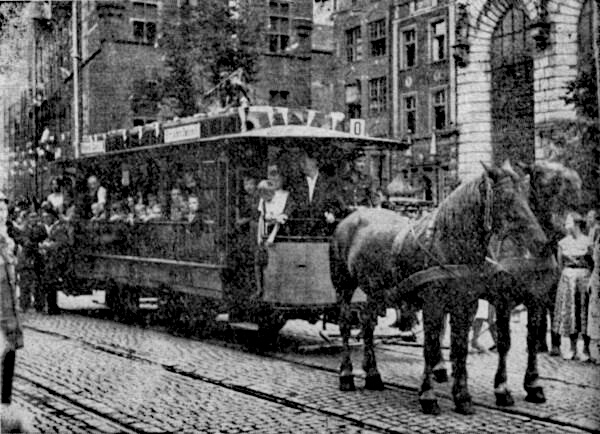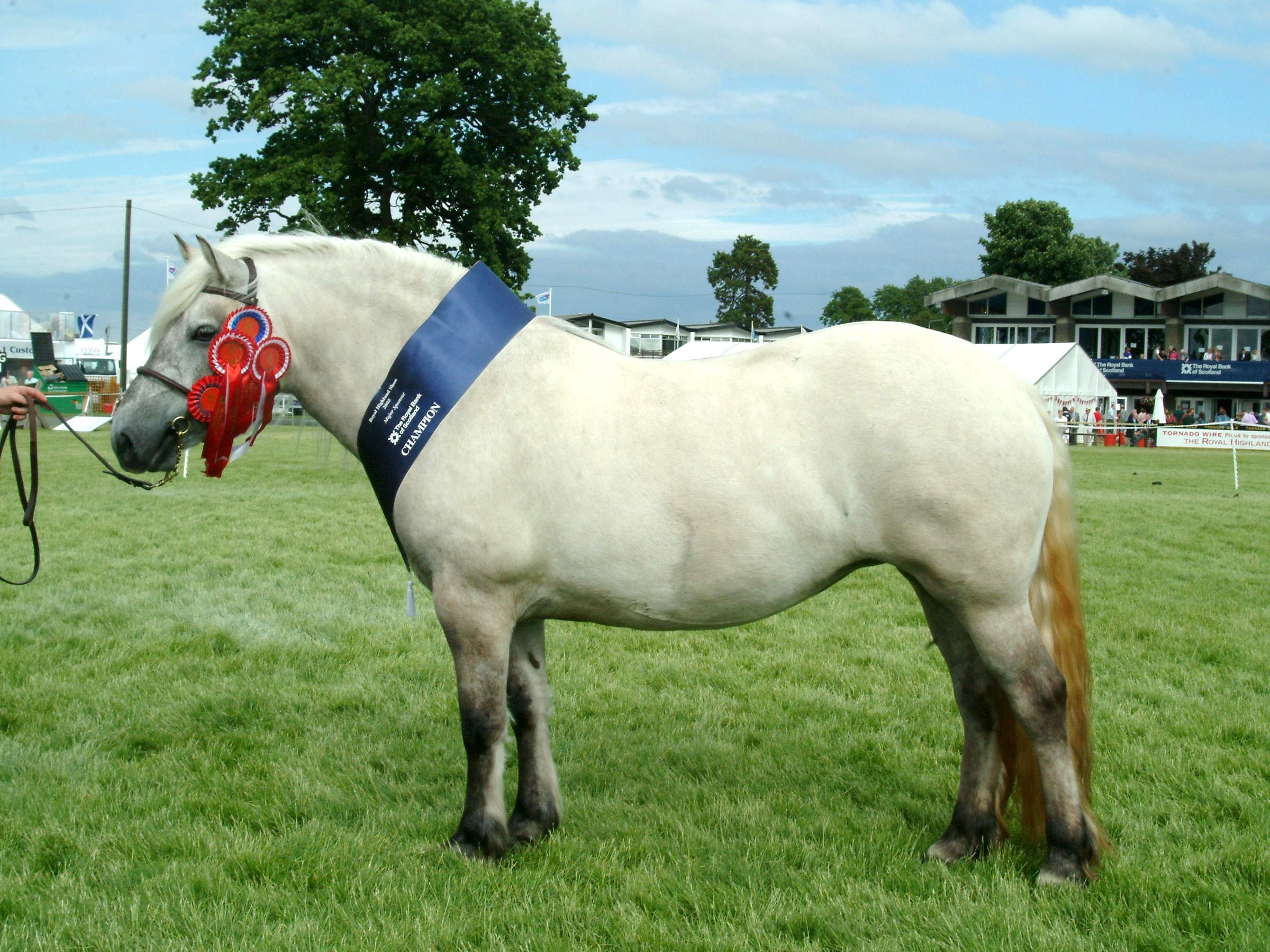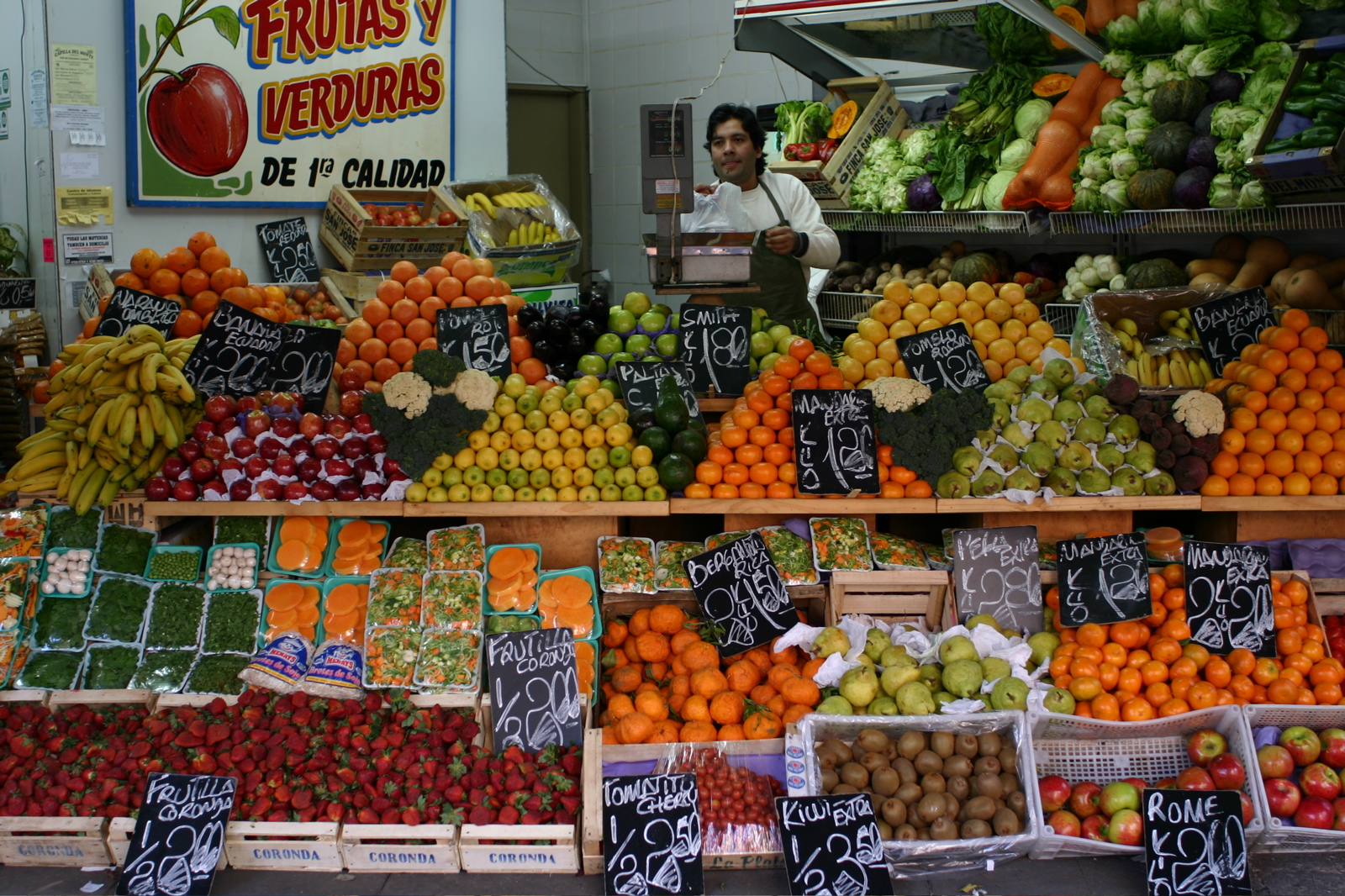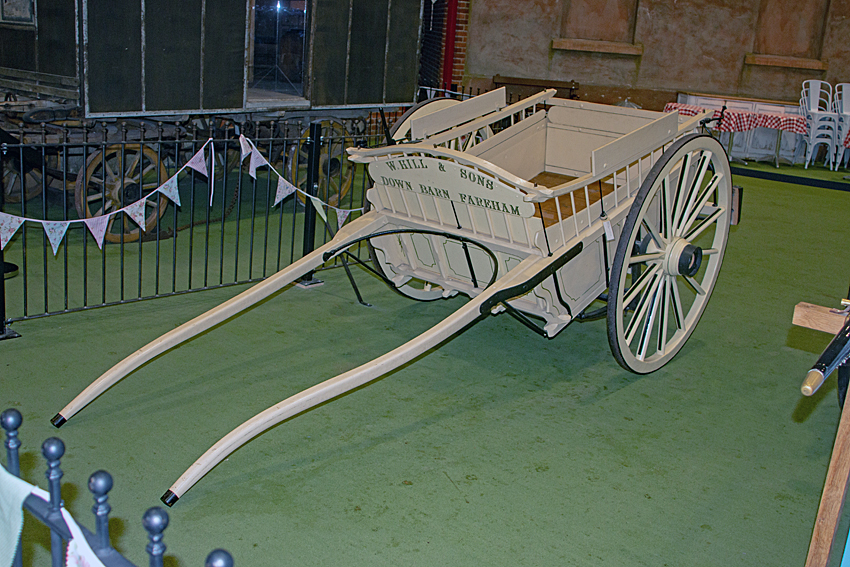|
Trolley (horse-drawn)
Among horse-drawn vehicles, a trolley was a goods vehicle with a platform body with four small wheels of equal size, mounted underneath it, the front two on a turntable undercarriage. The wheels were rather larger and the deck proportionately higher than those of a lorry. A large trolley is likely to have had a headboard with the driver's seat on it, as on a lorry but a smaller trolley may have had a box at the front of the deck or the driver seated on a corner of the deck and his feet on a shaft. With a very small trolley, the 'driver' may even have led the horse as a pedestrian. They were normally drawn by a single pony or horse but a large trolley would have a pair. It was primarily an urban vehicle so that, on the paved roads, the small wheels were not a handicap. In any case, the axles would normally be sprung. It was typically used by market fruiterers and greengrocers but commonly also by coal merchants. These would have a headboard to stabilize the front row of sacks whic ... [...More Info...] [...Related Items...] OR: [Wikipedia] [Google] [Baidu] |
Rag And Bone Man
A rag-and-bone man or ragpicker (UK English) or ragman, old-clothesman, junkman, or junk dealer (US English), also called a bone-grubber, bone-picker, chiffonnier, rag-gatherer, rag-picker, bag board, or totter, collects unwanted household items and sells them to merchants. Scraps of cloth and paper could be turned into cardboard, while broken glass could be melted down and reused, and even dead cats and dogs could be skinned to make clothes. Traditionally, this was a task performed on foot, with the scavenged materials (which included rags, bones and various metals to be scrapped) kept in a small bag slung over the shoulder. Some rag-and-bone men used a cart, sometimes pulled by a horse or pony. In the 19th century, rag-and-bone men typically lived in extreme poverty, surviving on the proceeds of what they collected each day. Conditions for rag-and-bone men in general improved following the Second World War, but the trade declined during the latter half of the 20th century. In ... [...More Info...] [...Related Items...] OR: [Wikipedia] [Google] [Baidu] |
Horse-drawn Vehicle
A horse-drawn vehicle is a piece of equipment pulled by one or more horses. These vehicles typically have two or four wheels and were used to carry passengers or a load. They were once common worldwide, but they have mostly been replaced by automobiles and other forms of self-propelled transport but are still in use today. General Horses were domesticated circa 2000 BCE. Before that oxen were used. Historically, a wide variety of arrangements of horses and vehicles have been used, from chariot racing, which involved a small vehicle and four horses abreast, to horsecars or trollies, which used two horses to pull a car that was used in cities before electric trams were developed. A two-wheeled horse-drawn vehicle is a cart (see various types below, both for carrying people and for goods). Four-wheeled vehicles have many names – one for heavy loads is most commonly called a wagon. Very light carts and wagons can also be pulled by Donkey, donkeys (much smaller than horses), pony ... [...More Info...] [...Related Items...] OR: [Wikipedia] [Google] [Baidu] |
Lorry (horse-drawn)
A lorry or lorrie was a low flat horse-drawn vehicle with no sides, related to the Trolley (horse-drawn), trolley and dray. Vehicle delivery trailer This version was a low-loading trolley (horse-drawn), trolley used mainly for the carriage of other vehicles, for example for delivery from the Coachbuilder#Horse-drawn origins, coachbuilders or returning there for repair. Its very small wheels were mounted under the deck which had to be wider than the track of the vehicles to be carried. It had two ramps, stowed above the back axle and below the body. These were withdrawn from the lorry and one end of each attached to the back of the deck while the other ends rested on the ground. A winch, mounted on the headboard was then used to draw the load up the ramps and onto the deck. The winch cable, low fixed sideboards and a low hinged tailboard plus lashings retained it there. The lorry was rather like a wooden version of the modern car-carrying trailer, intended for towing behind ... [...More Info...] [...Related Items...] OR: [Wikipedia] [Google] [Baidu] |
Pony
A pony is a type of small horse, usually measured under a specified height at maturity. Ponies often have thicker coats, manes and tails, compared to larger horses, and proportionally shorter legs, wider barrels, heavier , thicker necks and shorter heads. In modern use, breed registries and horse shows may define a pony as measuring at the withers below a certain height; height limits varying from about to . Some distinguish between horse or pony based on its breed or phenotype, regardless of its height. The word ''pony'' derives from the old French ''poulenet'', a diminutive of meaning foal, a young, immature horse. A full-sized horse may sometimes be called a pony as a term of endearment. Definition For many forms of competition, the official definition of a pony is a horse that measures up to at the withers. Standard horses are taller than 14.2. The International Federation for Equestrian Sports defines the official cutoff point at without shoes and with shoes ... [...More Info...] [...Related Items...] OR: [Wikipedia] [Google] [Baidu] |
Horse
The horse (''Equus ferus caballus'') is a domesticated, one-toed, hoofed mammal. It belongs to the taxonomic family Equidae and is one of two extant subspecies of ''Equus ferus''. The horse has evolved over the past 45 to 55 million years from a small multi-toed creature, '' Eohippus'', into the large, single-toed animal of today. Humans began domesticating horses around 4000 BCE in Central Asia, and their domestication is believed to have been widespread by 3000 BCE. Horses in the subspecies ''caballus'' are domesticated, although some domesticated populations live in the wild as feral horses. These feral populations are not true wild horses, which are horses that have never been domesticated. There is an extensive, specialized vocabulary used to describe equine-related concepts, covering everything from anatomy to life stages, size, colors, markings, breeds, locomotion, and behavior. Horses are adapted to run, allowing them to quickly escape predator ... [...More Info...] [...Related Items...] OR: [Wikipedia] [Google] [Baidu] |
Fruiterer
A greengrocer is a person who owns or operates a shop selling primarily fruit and vegetables. The term may also be used to refer to a shop selling primarily produce. It is used predominantly in the United Kingdom and Australia. In the United States, the terms ''produce store'' or ''produce shop'' are used. By the 1940s, produce sales (measured in tonnage) made at grocery stores had surpassed those made at produce stores. While once common in the United Kingdom and Australia, the increase in popularity of supermarkets caused greengrocer shops to become rarer, though they may still be found in smaller towns and villages. Today, greengrocers can also be found in street markets, malls, and supermarket produce departments. Greengrocers' apostrophe Because of its common misuse on greengrocers' signs (e.g ''apple's'', ''orange's'', or ''banana's''), an apostrophe used incorrectly to form a plural In many languages, a plural (sometimes list of glossing abbreviations, abbreviated ... [...More Info...] [...Related Items...] OR: [Wikipedia] [Google] [Baidu] |
Greengrocer
A greengrocer is a person who owns or operates a shop selling primarily produce, fruit and vegetables. The term may also be used to refer to a shop selling primarily produce. It is used predominantly in the United Kingdom and Australia. In the United States, the terms ''produce store'' or ''produce shop'' are used. By the 1940s, produce sales (measured in Tonnage#Non-maritime_usage_of_the_term_tonnage, tonnage) made at grocery stores had surpassed those made at produce stores. While once common in the United Kingdom and Australia, the increase in popularity of supermarkets caused greengrocer shops to become rarer, though they may still be found in smaller towns and villages. Today, greengrocers can also be found in street markets, malls, and supermarket produce departments. Greengrocers' apostrophe Because of its common misuse on greengrocers' signs (e.g ''apple's'', ''orange's'', or ''banana's''), an apostrophe used incorrectly to form a English plural, plural is known as a ... [...More Info...] [...Related Items...] OR: [Wikipedia] [Google] [Baidu] |
Coal Merchant
A coal merchant is the term used in the UK and other countries for a trader who sells coal and often delivers it to households. Coal merchants were once a major class of local business, but have declined in importance in many parts of the developed world due to the rise of alternative heating methods, including central heating, Gas heater, gas, Fuel oil, oil and electric heating. The men who carried the coal to households were called coal men. The mass of coal homes burned was large; the UK government estimated in 1975 that the average household burning solid fuel used about 4.7 tons per year. History According to John Ulric Nef (economic historian), J. U. Nef, the term "coal merchant" originally meant "the owner, or part owner, of an east-coast collier [ship]; but in the eighteenth century the word was applied to all kinds of London coal traders, including small retailers", while the shipper came to be called a coal dealer, although the terms were "seldom applied consistently" in ... [...More Info...] [...Related Items...] OR: [Wikipedia] [Google] [Baidu] |
Rag And Bone
A rag-and-bone man or ragpicker (UK English) or ragman, old-clothesman, junkman, or junk dealer (US English), also called a bone-grubber, bone-picker, chiffonnier, rag-gatherer, rag-picker, bag board, or totter, collects unwanted household items and sells them to merchants. Scraps of cloth and paper could be turned into cardboard, while broken glass could be melted down and reused, and even dead cats and dogs could be skinned to make clothes. Traditionally, this was a task performed on foot, with the scavenged materials (which included rags, bones and various metals to be scrapped) kept in a small bag slung over the shoulder. Some rag-and-bone men used a cart, sometimes pulled by a horse or pony. In the 19th century, rag-and-bone men typically lived in extreme poverty, surviving on the proceeds of what they collected each day. Conditions for rag-and-bone men in general improved following the Second World War, but the trade declined during the latter half of the 20th century. In ... [...More Info...] [...Related Items...] OR: [Wikipedia] [Google] [Baidu] |
Trolley And Lift Van
The trolley was a platform body with four relatively small wheels mounted underneath it, the front two on a turntable undercarriage. It was drawn by a pair of horses and the driver's seat was mounted on the headboard. The lift van was a sturdy wooden box to long, wide and high to the centre of the roof. It had two wrought iron straps passing down the sides and under the bottom, having a sling shackled to holes in the top ends of the straps so that the whole and its contents could be lifted by crane onto the trolley for movement by road, onto a railway truck or into the hold of a ship. It was therefore a logical step on from the pantechnicon van in the development of containerization. The system thereby provided a means of door-to-door transit and was used particularly for furniture removals. The furniture makers and merchants, Maple and Co., in particular, used it to deliver between their depôts in London and Paris. It was also used for the carriage of meat. In this case ... [...More Info...] [...Related Items...] OR: [Wikipedia] [Google] [Baidu] |
Milk Float
A milk float is a vehicle specifically designed for the Delivery (commerce), delivery of fresh milk. Today, milk floats are usually battery electric vehicles (BEV), but they were formerly Float (horse-drawn), horse-drawn floats. They were once common in many European countries, particularly the United Kingdom, and were operated by local dairy, dairies. However, in recent years, as the number of supermarkets, small independent grocers and petrol stations, and convenience stores stocking fresh milk has increased, many people have switched from regular home delivery to obtaining fresh milk from these other sources. Characteristics Because of the relatively small power output from its electric motor, a milk float travels fairly slowly, usually around although some have been modified to attain speeds of up to . Operators often exit their vehicle before they have completely stopped to speed up deliveries; milk floats generally have sliding doors that can be left open when movi ... [...More Info...] [...Related Items...] OR: [Wikipedia] [Google] [Baidu] |
Float (horse-drawn)
A float is a form of two-wheeled Horse-drawn vehicle, horse-drawn cart, often with a dropped axle to give an especially low load-bed. They were intended for use by deliverymen and the carrying of heavy or unstable items such as milk churns. Description The axle passes beneath the load-bed of the cart and is cranked upwards at each side, allowing the floor of the cart to be lower than the center of the wheels. This allows the load to be carried low, for stability and ease of loading with heavy objects such as churns or barrels. The high position of the axle ends allows large wheels, giving a smooth ride. The box body is often open at the rear, or has a tailboard which can be let down. Rather than a driving seat or box, they are driven from a standing position, alongside the load. Floats were drawn by a single horse or, especially in Ireland, a donkey. A rough type of float used in Ireland was called a ''shandrydan'' or ''shandydan''. Use Milk churns were transported to th ... [...More Info...] [...Related Items...] OR: [Wikipedia] [Google] [Baidu] |









